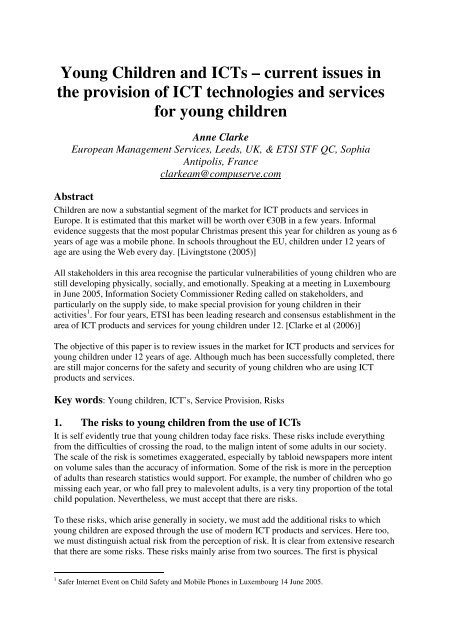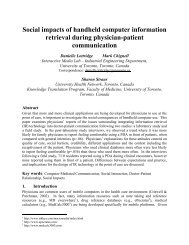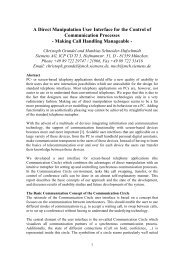Young Children and ICTs â current issues in the provision of ICT ...
Young Children and ICTs â current issues in the provision of ICT ...
Young Children and ICTs â current issues in the provision of ICT ...
Create successful ePaper yourself
Turn your PDF publications into a flip-book with our unique Google optimized e-Paper software.
<strong>Young</strong> <strong>Children</strong> <strong>and</strong> <strong><strong>ICT</strong>s</strong> – <strong>current</strong> <strong>issues</strong> <strong>in</strong><br />
<strong>the</strong> <strong>provision</strong> <strong>of</strong> <strong>ICT</strong> technologies <strong>and</strong> services<br />
for young children<br />
Anne Clarke<br />
European Management Services, Leeds, UK, & ETSI STF QC, Sophia<br />
Antipolis, France<br />
clarkeam@compuserve.com<br />
Abstract<br />
<strong>Children</strong> are now a substantial segment <strong>of</strong> <strong>the</strong> market for <strong>ICT</strong> products <strong>and</strong> services <strong>in</strong><br />
Europe. It is estimated that this market will be worth over €30B <strong>in</strong> a few years. Informal<br />
evidence suggests that <strong>the</strong> most popular Christmas present this year for children as young as 6<br />
years <strong>of</strong> age was a mobile phone. In schools throughout <strong>the</strong> EU, children under 12 years <strong>of</strong><br />
age are us<strong>in</strong>g <strong>the</strong> Web every day. [Liv<strong>in</strong>gtstone (2005)]<br />
All stakeholders <strong>in</strong> this area recognise <strong>the</strong> particular vulnerabilities <strong>of</strong> young children who are<br />
still develop<strong>in</strong>g physically, socially, <strong>and</strong> emotionally. Speak<strong>in</strong>g at a meet<strong>in</strong>g <strong>in</strong> Luxembourg<br />
<strong>in</strong> June 2005, Information Society Commissioner Red<strong>in</strong>g called on stakeholders, <strong>and</strong><br />
particularly on <strong>the</strong> supply side, to make special <strong>provision</strong> for young children <strong>in</strong> <strong>the</strong>ir<br />
activities 1 . For four years, ETSI has been lead<strong>in</strong>g research <strong>and</strong> consensus establishment <strong>in</strong> <strong>the</strong><br />
area <strong>of</strong> <strong>ICT</strong> products <strong>and</strong> services for young children under 12. [Clarke et al (2006)]<br />
The objective <strong>of</strong> this paper is to review <strong>issues</strong> <strong>in</strong> <strong>the</strong> market for <strong>ICT</strong> products <strong>and</strong> services for<br />
young children under 12 years <strong>of</strong> age. Although much has been successfully completed, <strong>the</strong>re<br />
are still major concerns for <strong>the</strong> safety <strong>and</strong> security <strong>of</strong> young children who are us<strong>in</strong>g <strong>ICT</strong><br />
products <strong>and</strong> services.<br />
Key words: <strong>Young</strong> children, <strong>ICT</strong>’s, Service Provision, Risks<br />
1. The risks to young children from <strong>the</strong> use <strong>of</strong> <strong><strong>ICT</strong>s</strong><br />
It is self evidently true that young children today face risks. These risks <strong>in</strong>clude everyth<strong>in</strong>g<br />
from <strong>the</strong> difficulties <strong>of</strong> cross<strong>in</strong>g <strong>the</strong> road, to <strong>the</strong> malign <strong>in</strong>tent <strong>of</strong> some adults <strong>in</strong> our society.<br />
The scale <strong>of</strong> <strong>the</strong> risk is sometimes exaggerated, especially by tabloid newspapers more <strong>in</strong>tent<br />
on volume sales than <strong>the</strong> accuracy <strong>of</strong> <strong>in</strong>formation. Some <strong>of</strong> <strong>the</strong> risk is more <strong>in</strong> <strong>the</strong> perception<br />
<strong>of</strong> adults than research statistics would support. For example, <strong>the</strong> number <strong>of</strong> children who go<br />
miss<strong>in</strong>g each year, or who fall prey to malevolent adults, is a very t<strong>in</strong>y proportion <strong>of</strong> <strong>the</strong> total<br />
child population. Never<strong>the</strong>less, we must accept that <strong>the</strong>re are risks.<br />
To <strong>the</strong>se risks, which arise generally <strong>in</strong> society, we must add <strong>the</strong> additional risks to which<br />
young children are exposed through <strong>the</strong> use <strong>of</strong> modern <strong>ICT</strong> products <strong>and</strong> services. Here too,<br />
we must dist<strong>in</strong>guish actual risk from <strong>the</strong> perception <strong>of</strong> risk. It is clear from extensive research<br />
that <strong>the</strong>re are some risks. These risks ma<strong>in</strong>ly arise from two sources. The first is physical<br />
1 Safer Internet Event on Child Safety <strong>and</strong> Mobile Phones <strong>in</strong> Luxembourg 14 June 2005.
safety concerns about <strong>the</strong> actual equipment. RSI caused by very young h<strong>and</strong>s us<strong>in</strong>g a keypad<br />
designed for adult h<strong>and</strong>s, known colloquially as ‘sms thumb’, is an example. These risks are<br />
due largely to poor physical design, which is addressed <strong>in</strong> detail <strong>in</strong> a new set <strong>of</strong> design<br />
guidel<strong>in</strong>es for <strong>ICT</strong> products targeted at young children, published as ETSI Guide 202 423<br />
[ETSI (2005)].<br />
The o<strong>the</strong>r major category <strong>of</strong> risks arises from <strong>the</strong> ma<strong>in</strong> characteristic <strong>of</strong> modern <strong><strong>ICT</strong>s</strong>. Mobile<br />
phones, email, <strong>and</strong> <strong>the</strong> Internet are communications products <strong>and</strong> services. The risks to young<br />
children arise because <strong>of</strong> <strong>the</strong> ability <strong>of</strong> <strong>the</strong> product or service to enable <strong>the</strong> child to<br />
communicate. While communication with family <strong>and</strong> close friends is considered essential for<br />
<strong>the</strong> child’s social development, what is less desirable, <strong>and</strong> very troubl<strong>in</strong>g for parents, is <strong>the</strong><br />
thought <strong>of</strong> <strong>the</strong> child communicat<strong>in</strong>g with unknown or undesirable contacts through text<br />
messag<strong>in</strong>g, email, chat rooms or o<strong>the</strong>r forms <strong>of</strong> electronically mediated <strong>in</strong>teraction. In this<br />
category I also <strong>in</strong>clude <strong>the</strong> case <strong>of</strong> young children who ga<strong>in</strong> access to harmful content (as a<br />
form <strong>of</strong> communication). At <strong>the</strong> extreme end <strong>of</strong> <strong>the</strong> spectrum <strong>of</strong> <strong>the</strong>se concerns is <strong>the</strong> thought<br />
that such <strong>in</strong>teractions might be tak<strong>in</strong>g place unsupervised, <strong>and</strong> lead eventually to ‘groom<strong>in</strong>g’,<br />
<strong>and</strong> to <strong>the</strong> most disastrous consequences <strong>of</strong> a child be<strong>in</strong>g harmed.<br />
There is a third category <strong>of</strong> risk, which arises from <strong>the</strong> misuse <strong>and</strong> abuse by <strong>the</strong> children<br />
<strong>the</strong>mselves. (see next section).<br />
The <strong>in</strong>cidence <strong>of</strong> actual harmful consequences to young children due solely to <strong>the</strong>ir use <strong>of</strong><br />
<strong><strong>ICT</strong>s</strong> is, thankfully, t<strong>in</strong>y. However <strong>the</strong> concerns rema<strong>in</strong>. As <strong>the</strong> market for services to young<br />
children grows, <strong>the</strong>se concerns are unlikely to decl<strong>in</strong>e, without appropriate actions by <strong>the</strong><br />
<strong>in</strong>dustry <strong>in</strong> concerted action with parent groups. The primary responsibility for <strong>the</strong> protection<br />
<strong>of</strong> children must lie with <strong>the</strong>ir parents/guardians. However it must be recognised that this<br />
ideal might not be realised <strong>in</strong> each <strong>and</strong> every case, despite earnest effort by all concerned.<br />
Even <strong>in</strong> <strong>the</strong> ideal case, <strong>the</strong>re rema<strong>in</strong> actions which service providers can take to reduce even<br />
<strong>the</strong> smallest risk.<br />
2. Social consequences <strong>of</strong> large scale deployment <strong>of</strong> <strong><strong>ICT</strong>s</strong><br />
The use <strong>of</strong> new technology <strong>in</strong> ways never orig<strong>in</strong>ally envisaged has consequences for society.<br />
For example, <strong>the</strong> misuse <strong>of</strong> <strong>the</strong> mobile technology by <strong>the</strong> children <strong>the</strong>mselves has given rise to<br />
a subculture <strong>of</strong> <strong>ICT</strong> abuse among <strong>the</strong> young, <strong>and</strong> also among older children. Examples <strong>in</strong>clude<br />
bully<strong>in</strong>g by means <strong>of</strong> text messages, ‘bluejack<strong>in</strong>g’, <strong>and</strong> ‘happy slapp<strong>in</strong>g’, a form <strong>of</strong> common<br />
assault, <strong>the</strong> motive for which <strong>in</strong>cludes <strong>the</strong> ability to make a record<strong>in</strong>g <strong>of</strong> <strong>the</strong> assault on camera<br />
phones. Ano<strong>the</strong>r example is <strong>the</strong> proliferation <strong>of</strong> <strong>the</strong> ‘Am I hot or not?’ rat<strong>in</strong>g type web pages,<br />
where young people are be<strong>in</strong>g encouraged to make cruel, <strong>and</strong> even <strong>of</strong>fensive comments about<br />
each o<strong>the</strong>r, or about <strong>the</strong>ir teachers, parents etc.<br />
These social consequences arise through provid<strong>in</strong>g young children with new communications<br />
facilities without hav<strong>in</strong>g a clear underst<strong>and</strong><strong>in</strong>g <strong>of</strong> <strong>the</strong>ir needs for communication or <strong>the</strong>ir<br />
ability to deal with new communications channels, or how to encourage positive usage <strong>and</strong> to<br />
discourage, or prevent usage lead<strong>in</strong>g to negative social consequences.<br />
Much <strong>of</strong> <strong>the</strong> work on <strong>the</strong>se types <strong>of</strong> behaviours requires a deep underst<strong>and</strong><strong>in</strong>g <strong>of</strong> child<br />
development <strong>and</strong> behavioural psychology, <strong>and</strong> <strong>of</strong> <strong>the</strong> feedback between new communications<br />
capabilities mediated through technologies <strong>and</strong> antisocial behaviour among young children.<br />
Given that we, as adults, struggle to cope with <strong>the</strong> dem<strong>and</strong>s <strong>of</strong> today’s 24/7, broadb<strong>and</strong>
communications world, <strong>the</strong>n we cannot expect our children to fare better. The questions<br />
parents <strong>and</strong> child experts are ask<strong>in</strong>g are firstly how to deal with such emergent behavioral<br />
trends, <strong>and</strong> secondly what assistance can <strong>the</strong>y expect from <strong>the</strong> technologists, <strong>and</strong> o<strong>the</strong>rs, who<br />
work for <strong>the</strong> <strong>ICT</strong> product <strong>and</strong> service providers? Surely we do not advocate a strategy where<br />
<strong>the</strong> <strong>in</strong>dustry deploys, <strong>and</strong> <strong>the</strong> rest <strong>of</strong> society must deal with <strong>the</strong> consequences, however<br />
uncomfortable <strong>and</strong> worry<strong>in</strong>g <strong>the</strong>se consequences may be for our children?<br />
3. Why young children are a ‘protected market’<br />
Due to <strong>the</strong> supervisory <strong>and</strong> oversight functions <strong>and</strong> obligations <strong>of</strong> parents, <strong>the</strong> children’s<br />
market has features which are unique. In effect, without <strong>the</strong> approval <strong>of</strong> parents, it is very<br />
difficult for suppliers <strong>of</strong> any product or service targeted at young children to succeed.<br />
The market also relies to an extraord<strong>in</strong>ary extent on pester power. The customer, <strong>in</strong> this case a<br />
young child, is <strong>in</strong>sufficiently aware <strong>of</strong> <strong>the</strong> features <strong>of</strong> <strong>the</strong> product or service, because <strong>the</strong>y are<br />
too young. Thus market<strong>in</strong>g <strong>and</strong> advertis<strong>in</strong>g relies on <strong>the</strong> child’s perception <strong>of</strong> need, <strong>and</strong> on <strong>the</strong><br />
child press<strong>in</strong>g <strong>the</strong> parent hard to buy <strong>the</strong> product or service. There has been much discussion<br />
<strong>of</strong> this particular feature <strong>of</strong> this market, <strong>in</strong>clud<strong>in</strong>g possible action by various regulatory<br />
authorities to curtail <strong>the</strong> actions <strong>of</strong> suppliers <strong>of</strong> o<strong>the</strong>r, i.e. non-<strong>ICT</strong>, products. [Which? (Jan<br />
2006)] The question <strong>of</strong> <strong>the</strong> use <strong>of</strong> pester power rema<strong>in</strong>s an issue for <strong>ICT</strong> service providers.<br />
In addition to all this, it has been shown that young children need products specially designed<br />
to take account <strong>of</strong> <strong>the</strong> fact that <strong>the</strong>ir physical faculties are not yet fully developed. H<strong>and</strong>s,<br />
f<strong>in</strong>gers <strong>and</strong> eyes do not have <strong>the</strong> same characteristics as those <strong>of</strong> adults. Because <strong>of</strong> <strong>the</strong>se<br />
particular characteristics, it is better for suppliers <strong>in</strong> general to consider young children as a<br />
‘protected market’. It is clear that young children do have needs. Specifically, <strong>the</strong>y have<br />
needs, commensurate with <strong>the</strong> stage <strong>of</strong> <strong>the</strong>ir development <strong>the</strong>y have reached, for <strong>ICT</strong> products<br />
<strong>and</strong> services. However, acquisition <strong>of</strong> such products <strong>and</strong> services has to rely on purchas<strong>in</strong>g by<br />
parents. Fur<strong>the</strong>rmore, <strong>and</strong> s<strong>in</strong>ce young children cannot legally enter <strong>in</strong>to contracts, <strong>the</strong>y have<br />
to rely on <strong>the</strong> parent <strong>in</strong> this respect as well.<br />
All <strong>of</strong> this means that suppliers <strong>of</strong> <strong>ICT</strong> products <strong>and</strong> services for young children have to<br />
behave differently than <strong>the</strong>y would if <strong>the</strong> market was made up <strong>of</strong> adults. Hence <strong>the</strong> use <strong>of</strong> <strong>the</strong><br />
term protected market.<br />
4. New technologies likely to <strong>in</strong>crease <strong>the</strong> risks for young children<br />
Today’s <strong><strong>ICT</strong>s</strong> are about to be replaced <strong>and</strong> superceded by a new range <strong>of</strong> communications<br />
products <strong>and</strong> services. The next generation <strong>of</strong> <strong>ICT</strong> products <strong>and</strong> services will extend <strong>the</strong><br />
power, reach, <strong>and</strong> universality <strong>of</strong> <strong>in</strong>terwork<strong>in</strong>g <strong>and</strong> <strong>in</strong>ternetwork<strong>in</strong>g products. Pervasive <strong>and</strong><br />
ubiquitous comput<strong>in</strong>g products, embedded <strong>and</strong> wearable communicat<strong>in</strong>g devices, <strong>and</strong> ad hoc<br />
network<strong>in</strong>g technologies will br<strong>in</strong>g a paradigm shift greater than that precipitated by <strong>the</strong><br />
telephone, <strong>the</strong> <strong>in</strong>ternet <strong>and</strong> <strong>the</strong> mobile phone taken toge<strong>the</strong>r.<br />
The scope <strong>and</strong> scale <strong>of</strong> <strong>the</strong> communications pathways <strong>in</strong> today’s <strong>in</strong>formation society def<strong>in</strong>es<br />
<strong>the</strong> fundamental characteristics <strong>of</strong> <strong>the</strong> modern world. Email, chat rooms, <strong>the</strong> mobile phone,<br />
web blogg<strong>in</strong>g <strong>and</strong> <strong>the</strong> ubiquitous power <strong>of</strong> <strong>the</strong> press, <strong>and</strong> <strong>of</strong> radio <strong>and</strong> TV broadcast<strong>in</strong>g<br />
services, drive <strong>the</strong> <strong>current</strong> <strong>in</strong>formation age. Instant <strong>and</strong> worldwide <strong>in</strong>formation dissem<strong>in</strong>ation<br />
is <strong>the</strong> norm. News <strong>of</strong> earthquakes <strong>and</strong> <strong>the</strong> destructive power <strong>of</strong> hurricanes arrives <strong>in</strong> real time.<br />
Nobody with a mobile phone is out <strong>of</strong> reach <strong>of</strong> friends <strong>and</strong> family. If we now propose to<br />
change fundamentally <strong>the</strong> way <strong>the</strong> next generation <strong>of</strong> communications technologies enables
<strong>in</strong>terpersonal communication, <strong>the</strong>n we have to be aware that <strong>the</strong>re will be new social<br />
consequences. This is especially <strong>the</strong> case for young children. The ma<strong>in</strong> concern will be that<br />
<strong>the</strong> risks <strong>of</strong> harmful contacts, outside <strong>of</strong> direct parental supervision will <strong>in</strong>crease. As an<br />
example, consider Location Based Services (LBS). Today, <strong>the</strong> accuracy <strong>of</strong> <strong>the</strong> location is<br />
limited to <strong>the</strong> size <strong>of</strong> <strong>the</strong> mobile cell <strong>in</strong> which <strong>the</strong> mobile phone is operat<strong>in</strong>g. The question<br />
parents are ask<strong>in</strong>g is “if I can establish <strong>the</strong> location <strong>of</strong> my child with this technology, can<br />
anyone else do this?”. Even with safeguards <strong>in</strong> place, <strong>the</strong> activities <strong>of</strong> hackers <strong>and</strong> <strong>the</strong><br />
perverted actions <strong>of</strong> those who prey on young children, could make a child less safe because<br />
<strong>of</strong> this technology. Law enforcement authorities <strong>in</strong> a number <strong>of</strong> countries are becom<strong>in</strong>g<br />
<strong>in</strong>creas<strong>in</strong>gly concerned about this technology.<br />
Next generation LBS will put satellite position<strong>in</strong>g technology <strong>in</strong>to mobile phones. This will<br />
improve <strong>the</strong> accuracy <strong>of</strong> location to about 3m. Will this make a child more or less safe? If ad<br />
hoc network<strong>in</strong>g capability is <strong>the</strong>n added, where <strong>the</strong> child’s mobile can form communications<br />
sub-networks with anyone else on a street who has a mobile phone, will this make <strong>the</strong> child<br />
more or less safe?<br />
LBS is just an example. O<strong>the</strong>r examples <strong>in</strong>clude on-l<strong>in</strong>e gambl<strong>in</strong>g (<strong>the</strong> natural extension <strong>of</strong><br />
on-l<strong>in</strong>e gam<strong>in</strong>g), access to video stream<strong>in</strong>g <strong>of</strong> harmful content at broadb<strong>and</strong> speeds on mobile<br />
technology, <strong>and</strong> <strong>the</strong> extensive use <strong>of</strong> automatic subscription services, seen today <strong>in</strong> <strong>the</strong> r<strong>in</strong>g<br />
tones phenomenon, but easily extensible to much more costly services <strong>in</strong> <strong>the</strong> future. All <strong>of</strong><br />
<strong>the</strong>se technology trends present new challenges for young children, <strong>and</strong> for <strong>the</strong>ir parents, who<br />
are struggl<strong>in</strong>g to cope with <strong>the</strong> downside <strong>of</strong> today’s technology. What will parents need to say<br />
to <strong>the</strong>ir children a few years from now about safe use <strong>of</strong> communications technologies? How<br />
much do we expect parents to know <strong>in</strong> depth about modern <strong><strong>ICT</strong>s</strong> <strong>and</strong> how <strong>the</strong>y operate?<br />
5. Best practice <strong>ICT</strong> education for young children<br />
It might be considered that all <strong>of</strong> this argues for strict education <strong>of</strong> young children <strong>in</strong> <strong>the</strong><br />
features, good <strong>and</strong> bad, <strong>of</strong> communications products <strong>and</strong> services. Clearly, education has a<br />
major role to play. Best practice examples, <strong>in</strong>clud<strong>in</strong>g safe text<strong>in</strong>g <strong>and</strong> search<strong>in</strong>g guides, <strong>and</strong><br />
guidel<strong>in</strong>es for better chat room practice will help.<br />
At a more fundamental level, <strong>the</strong>re is a list <strong>of</strong> important questions about young children <strong>and</strong><br />
<strong><strong>ICT</strong>s</strong> which need to be addressed. This list would <strong>in</strong>clude questions such as:<br />
At what age should a young child -<br />
own a mobile phone?<br />
have <strong>the</strong>ir own doma<strong>in</strong> name?<br />
create <strong>and</strong> ma<strong>in</strong>ta<strong>in</strong> <strong>the</strong>ir own web page?<br />
start blogg<strong>in</strong>g, or MSN type messag<strong>in</strong>g, or us<strong>in</strong>g chat rooms?<br />
be allowed to use chat rooms unsupervised?<br />
Do parents have a right to look at a child’s text messages, emails, or blogs? Until what age?<br />
There is a clear need to develop a set <strong>of</strong> age related digital competencies for young children,<br />
analogous to similar age related literacy or numeracy skills competence. <strong>Young</strong> children<br />
today are grow<strong>in</strong>g up <strong>in</strong> an Information Society, <strong>and</strong> will, as adults, work predom<strong>in</strong>antly <strong>in</strong><br />
<strong>the</strong> knowledge economy. This implies that <strong>in</strong> a real sense <strong>the</strong> future <strong>of</strong> <strong>the</strong> European<br />
knowledge society is today’s 4 to 12 year olds. They learn <strong>and</strong> play with <strong><strong>ICT</strong>s</strong> <strong>in</strong> <strong>the</strong> same<br />
way as previous generations used pencil <strong>and</strong> paper, slide rules, <strong>and</strong> pr<strong>in</strong>ted dictionaries. A<br />
range <strong>of</strong> achievable, age related digital competence goals needs to be established, <strong>in</strong> order to
help teachers <strong>and</strong> parents ensure that young children are not just familiar with mobile phones<br />
<strong>and</strong> <strong>in</strong>ternet term<strong>in</strong>als. <strong>Young</strong> children must also be educated about <strong>the</strong> risks, real <strong>and</strong><br />
perceived, <strong>and</strong> be shown best practice examples <strong>of</strong> <strong>ICT</strong> use commensurate with <strong>the</strong>ir social<br />
development. This will be one <strong>of</strong> <strong>the</strong> <strong>issues</strong> to be researched <strong>in</strong> <strong>the</strong> new ETSI project on<br />
guidel<strong>in</strong>es for service providers, which is to start soon 2 .<br />
6. The responsibilities <strong>of</strong> parents <strong>of</strong> young children us<strong>in</strong>g <strong><strong>ICT</strong>s</strong><br />
Service providers, politicians <strong>and</strong> regulators are very quick to po<strong>in</strong>t out that parents are<br />
fundamentally responsible for a child’s education, security <strong>and</strong> even behaviour (witness <strong>the</strong><br />
ASBO (Anti Social Behaviour Orders) culture <strong>in</strong> <strong>the</strong> UK). However, most parents today are<br />
not sufficiently aware <strong>of</strong> <strong>the</strong> features <strong>of</strong> today’s <strong>ICT</strong> products <strong>and</strong> services. Of course some<br />
are quite advanced, knowledgeable users <strong>the</strong>mselves, but this does not mean that even <strong>the</strong>y<br />
necessarily underst<strong>and</strong> <strong>the</strong> full implications <strong>of</strong> products <strong>and</strong> services <strong>in</strong> use by young children.<br />
In addition, <strong>the</strong>re is a large percentage who freely admit that <strong>the</strong>y can’t even operate <strong>the</strong> TV<br />
remote, let alone surf <strong>the</strong> web or configure mobile phone features.<br />
This means that awareness actions, such as INSAFE, have much work to do to <strong>in</strong>form parents<br />
about modern <strong><strong>ICT</strong>s</strong>. In particular, <strong>and</strong> as I mentioned above, parents need help to underst<strong>and</strong><br />
<strong>the</strong> communications potential <strong>of</strong> modern <strong><strong>ICT</strong>s</strong>. Underst<strong>and</strong><strong>in</strong>g this issue alone, would provide<br />
a powerful impetus for parental supervision <strong>and</strong> monitor<strong>in</strong>g <strong>of</strong> <strong>the</strong>ir children’s communication<br />
practices. Of course, this is a social <strong>and</strong> psychological dilemma for parents. When to<br />
<strong>in</strong>tervene, how to deal with ‘suspect’ activities, what to say to young children whose friends<br />
<strong>and</strong> peers appear to be allowed freedoms that are worry<strong>in</strong>g, <strong>the</strong>se, <strong>and</strong> many o<strong>the</strong>r challenges<br />
need to be met by today’s parents. Indeed this is not a new challenge for parents, who have<br />
struggled with similar concerns for generations. What is new is <strong>the</strong> pervasiveness <strong>and</strong><br />
portability <strong>of</strong> modern <strong><strong>ICT</strong>s</strong>, which result <strong>in</strong> <strong>in</strong>creas<strong>in</strong>g communications activities by young<br />
children away from adult supervision.<br />
The <strong>ICT</strong> <strong>in</strong>dustry can do more to help here, <strong>and</strong> not just by produc<strong>in</strong>g leaflets <strong>and</strong> booklets <strong>of</strong><br />
guidance for parents. [Vodafone (2005)] The <strong>in</strong>dustry, tak<strong>in</strong>g its corporate social<br />
responsibility seriously, can curtail <strong>and</strong> restrict some aspects <strong>of</strong> services for young children <strong>in</strong><br />
order to remove <strong>the</strong> worry for parents at source.<br />
7. Corporate social responsibility<br />
Our concern here is about what parents th<strong>in</strong>k about expos<strong>in</strong>g <strong>the</strong>ir children fully to <strong>the</strong><br />
market, <strong>and</strong> to <strong>the</strong> actions <strong>of</strong> service providers. Theoretical considerations about <strong>the</strong> nature<br />
<strong>and</strong> control <strong>of</strong> markets are beyond <strong>the</strong> scope <strong>of</strong> this paper. However, <strong>the</strong>re are practical<br />
concerns, <strong>and</strong> direct actions, which service providers <strong>in</strong> <strong>the</strong> <strong>ICT</strong> sector could address, if <strong>the</strong>re<br />
was general agreement to do so. The background to this is <strong>the</strong> legal framework with<strong>in</strong> which<br />
all service providers operate, <strong>and</strong> <strong>in</strong> particular <strong>the</strong> data protection legislation. [EC directives<br />
(1995 & 2002)]. The ma<strong>in</strong> question here is whe<strong>the</strong>r service providers, act<strong>in</strong>g toge<strong>the</strong>r, should<br />
consider a voluntary restra<strong>in</strong>t <strong>of</strong> normal practice, when <strong>the</strong> customer is a child under 12 years<br />
<strong>of</strong> age? A range <strong>of</strong> possible restrictions could be discussed. Some <strong>of</strong> <strong>the</strong>se restra<strong>in</strong>ts might<br />
<strong>in</strong>clude a ban on automatic signup messages (for example for r<strong>in</strong>g tones), <strong>and</strong> a restriction on<br />
direct f<strong>in</strong>ancial transactions. The possibility <strong>of</strong> a ban on access to LBS on children’s phones<br />
should be top <strong>of</strong> <strong>the</strong> list.<br />
2 Specialist Task Force QC (ETSI/HF) on Specification <strong>and</strong> guidel<strong>in</strong>es for service providers on <strong>the</strong> <strong>provision</strong> <strong>of</strong><br />
<strong>in</strong>formation services to children see http://www.etsi.org
More generally, this raises <strong>the</strong> question <strong>of</strong> whe<strong>the</strong>r or not service providers should be told that<br />
a particular product or service is <strong>in</strong> use by a young child. For example, if <strong>the</strong>re was a<br />
requirement to make service providers aware that a mobile phone, or some web service, was<br />
be<strong>in</strong>g used by a young child, <strong>the</strong>n it would make fur<strong>the</strong>r actions by service providers <strong>in</strong> <strong>the</strong><br />
<strong>in</strong>terest <strong>of</strong> better child security easier. It could also be argued that this would protect service<br />
providers from possible legal action if it were proved that a child or <strong>in</strong>deed children generally<br />
had <strong>in</strong> some way suffered as a consequence <strong>of</strong> actions <strong>of</strong> <strong>the</strong> service provider.<br />
The technical <strong>and</strong> adm<strong>in</strong>istrative <strong>issues</strong> this raises, may, <strong>in</strong>itially at least, cause many service<br />
providers to reject this idea. Someone, <strong>the</strong> child’s parents most likely, would have to <strong>in</strong>form<br />
<strong>the</strong> service provider that a particular product or service is <strong>in</strong> use by a young child. Parents<br />
would need reassurance that such a database <strong>of</strong> child users was totally secure, <strong>and</strong> that access<br />
to <strong>the</strong> data was only by authorised <strong>and</strong> tra<strong>in</strong>ed staff. From <strong>the</strong> service providers viewpo<strong>in</strong>t, <strong>the</strong><br />
extra costs <strong>of</strong> adm<strong>in</strong>ister<strong>in</strong>g such as system might be substantial, but <strong>the</strong>y would not be<br />
prohibitive.<br />
However if we now look at <strong>the</strong> data protection considerations, it might be argued that a young<br />
child cannot be aware <strong>of</strong> <strong>the</strong> consequences <strong>of</strong> a purchase <strong>of</strong> an <strong>ICT</strong> product, or agree<strong>in</strong>g to an<br />
action which potentially allows <strong>the</strong>ir personal details to be used <strong>in</strong> <strong>the</strong> same manner as that <strong>of</strong><br />
an adults. This <strong>in</strong> turn might argue that <strong>the</strong> service provider needs to be aware that a particular<br />
customer is a young child.<br />
The general case about market forces, free trade, <strong>and</strong> <strong>the</strong> characteristics <strong>of</strong> today’s economic<br />
framework is not under discussion here. What is needed is an open discussion <strong>of</strong> <strong>the</strong> costs,<br />
<strong>and</strong> benefits, <strong>of</strong> specific actions for both sides, children as well as service providers, with<strong>in</strong><br />
<strong>the</strong> exist<strong>in</strong>g legal framework, <strong>in</strong>clud<strong>in</strong>g data protection. What must be avoided, if at all<br />
possible, is over regulation <strong>of</strong> <strong>the</strong> sector. If national adm<strong>in</strong>istrations are moved to action by<br />
<strong>the</strong> concerns <strong>of</strong> parents <strong>and</strong> parent groups, <strong>the</strong>n <strong>the</strong> <strong>in</strong>dustry as a whole will have to face <strong>the</strong><br />
consequences. This will not necessarily make children any safer. However, <strong>the</strong> consequent<br />
costs, both f<strong>in</strong>ancial <strong>and</strong> <strong>in</strong> terms <strong>of</strong> negative publicity, would be very large.<br />
8. What has been done so far?<br />
Much good work is be<strong>in</strong>g undertaken at a European level with regard to young children’s <strong>ICT</strong><br />
use. For example <strong>the</strong> EU Safer Internet Programme aims to raise awareness <strong>of</strong> <strong>the</strong> safer use<br />
<strong>of</strong> <strong>the</strong> Internet by children. There are a number <strong>of</strong> projects under this umbrella, such as<br />
INSAFE, SAFT, AWAREU 3 . The European School Net exposes many <strong>of</strong> <strong>the</strong> <strong>issues</strong> <strong>in</strong><br />
relation to <strong>ICT</strong> use by children.<br />
For <strong>the</strong> past 4 years, ETSI has been <strong>in</strong>vestigat<strong>in</strong>g <strong>the</strong> st<strong>and</strong>ardisation <strong>issues</strong> <strong>in</strong> relation to <strong>ICT</strong><br />
use by young children. Ano<strong>the</strong>r paper at this conference gives more details <strong>of</strong> <strong>the</strong> work<br />
undertaken so far. In particular two reports have been produced, TR 102 133 [ETSI (2003)]<br />
focuss<strong>in</strong>g on <strong>the</strong> <strong>issues</strong> <strong>in</strong> relation to <strong>ICT</strong> be<strong>in</strong>g used by young children <strong>and</strong> EG 202 423 ETSI<br />
(2005)] which looks at design guidel<strong>in</strong>es for <strong>ICT</strong> products <strong>and</strong> services to be used by children<br />
under 12.<br />
3 EU Safer Internet Programme http://europa.eu.<strong>in</strong>t/<strong>in</strong>formation_society/activities/sip/<strong>in</strong>dex_en.htm
The use <strong>of</strong> <strong>ICT</strong> by children is seen as a ‘hot topic’ with<strong>in</strong> <strong>the</strong> <strong>in</strong>dustry. For example, a<br />
number <strong>of</strong> mobile operators with<strong>in</strong> <strong>the</strong> UK have set a Code <strong>of</strong> Practice for new forms <strong>of</strong><br />
content on mobile phones.[O2 et al (2003)] As part <strong>of</strong> this a classification framework will be<br />
established to classify content as not be<strong>in</strong>g suitable for under 18’s. This needs to be extended<br />
to differentiate content that is appropriate for children <strong>of</strong> different age groups.<br />
Access by young children to pornographic <strong>and</strong> o<strong>the</strong>r <strong>in</strong>appropriate content via <strong>the</strong> <strong>in</strong>ternet is<br />
<strong>of</strong> concern to many parents <strong>and</strong> guardians. Much effort, <strong>and</strong> some bl<strong>in</strong>d faith, has been<br />
<strong>in</strong>vested <strong>in</strong> block<strong>in</strong>g s<strong>of</strong>tware <strong>and</strong> content filters. However, <strong>the</strong>re rema<strong>in</strong> doubts about all<br />
filter<strong>in</strong>g technologies. Firstly, <strong>the</strong>y need ma<strong>in</strong>tenance <strong>and</strong> supervision by adults. Secondly,<br />
<strong>the</strong>y have flaws which sometimes cause un<strong>in</strong>tended block<strong>in</strong>g <strong>of</strong> allowed content. <strong>Young</strong><br />
children like a challenge, <strong>and</strong> break<strong>in</strong>g <strong>the</strong> security <strong>of</strong> <strong>the</strong> filter<strong>in</strong>g s<strong>of</strong>tware has become a sort<br />
<strong>of</strong> ‘underground’ game for many young people at vulnerable stages <strong>in</strong> <strong>the</strong>ir development. The<br />
serious issue <strong>of</strong> supplier implementation <strong>and</strong> adherence to voluntary rat<strong>in</strong>g schemes is ano<strong>the</strong>r<br />
difficulty. F<strong>in</strong>ally, as revealed by Which? [Which (Feb 2006)] recently, <strong>the</strong>re are security<br />
loopholes <strong>in</strong> all <strong>of</strong> <strong>the</strong>se types <strong>of</strong> systems, which can be exploited relatively easily. One such<br />
loophole <strong>in</strong>volved children who were gett<strong>in</strong>g access codes for pornographic material via text<br />
messages.<br />
9. Issues which need address<strong>in</strong>g<br />
This review shows that substantial progress has taken place <strong>in</strong> <strong>the</strong> area <strong>of</strong> young children <strong>and</strong><br />
<strong><strong>ICT</strong>s</strong>. However, much still rema<strong>in</strong>s to be done. The most urgent need is to address <strong>the</strong> <strong>issues</strong><br />
surround<strong>in</strong>g LBS. Codes <strong>of</strong> practice not withst<strong>and</strong><strong>in</strong>g, <strong>the</strong>re are emerg<strong>in</strong>g concerns on two<br />
levels. The first I have dealt with above, <strong>and</strong> is about whe<strong>the</strong>r or not LBS makes young<br />
children more safe or less safe. The second issue is <strong>the</strong> grow<strong>in</strong>g concern that parents are be<strong>in</strong>g<br />
misled about what LBS is, <strong>and</strong> what it can do. In <strong>the</strong> UK, for example, <strong>the</strong>re is a voluntary<br />
Code <strong>of</strong> Practice for LBS suppliers.[Work<strong>in</strong>g group <strong>of</strong> UK location service providers (2004)].<br />
There is some evidence that suppliers are not comply<strong>in</strong>g strictly with <strong>the</strong> terms <strong>of</strong> <strong>the</strong> Code.<br />
Ano<strong>the</strong>r major concern is about <strong>the</strong> rate <strong>of</strong> evolution <strong>of</strong> technologies, <strong>and</strong> <strong>of</strong> emerg<strong>in</strong>g<br />
products <strong>and</strong> services. It is difficult for parents, without considerable experience <strong>of</strong> <strong><strong>ICT</strong>s</strong>, to<br />
know where to draw <strong>the</strong> boundaries for <strong>the</strong> children’s use <strong>of</strong> today’s <strong><strong>ICT</strong>s</strong>. It is almost<br />
impossible for <strong>the</strong>m to underst<strong>and</strong> future products <strong>and</strong> services. Evaluation <strong>of</strong> <strong>the</strong> potential<br />
risks to young children <strong>of</strong> us<strong>in</strong>g new <strong>ICT</strong> products <strong>and</strong> services is a major research<br />
undertak<strong>in</strong>g. This effort will take time, <strong>and</strong> <strong>the</strong>refore guidel<strong>in</strong>es <strong>and</strong> o<strong>the</strong>r support for parents<br />
<strong>and</strong> young children necessarily lags beh<strong>in</strong>d large scale deployment. We need to f<strong>in</strong>d a way to<br />
deal with this, preferable through <strong>the</strong> use <strong>of</strong> technology neutral guidel<strong>in</strong>es – both for parents<br />
<strong>and</strong> young children, as well as for service providers. This would mean that parents could rely<br />
on <strong>the</strong> fact that suppliers will cont<strong>in</strong>ue to follow <strong>the</strong> ‘rules’, even when next generation <strong><strong>ICT</strong>s</strong><br />
are deployed.<br />
Draw<strong>in</strong>g up a set <strong>of</strong> rules about how service providers, <strong>and</strong> <strong>the</strong> <strong>in</strong>dustry <strong>in</strong> general, deals with<br />
customers who happen to be young children is ano<strong>the</strong>r priority. The avoidance <strong>of</strong> over<br />
regulation is not <strong>the</strong> only benefit to service providers from such an approach. On <strong>the</strong> positive<br />
side, self regulation is seen by parents <strong>and</strong> child agencies as a more effective approach to <strong>the</strong><br />
<strong>issues</strong> we have discussed <strong>in</strong> this paper.<br />
It is time to consider <strong>the</strong> benefits for service providers <strong>of</strong> a 'ChildFriendly' scheme. This<br />
would take <strong>the</strong> form <strong>of</strong> a code <strong>of</strong> practice, drawn up by <strong>the</strong> <strong>in</strong>dustry, <strong>and</strong> by each service
provider. The code would declare those aspects <strong>of</strong> <strong>the</strong> operations which <strong>the</strong> service provider<br />
had specifically organised to take <strong>in</strong>to account <strong>the</strong> needs <strong>of</strong> its young children customers. It<br />
would <strong>in</strong>clude aspects such as special tra<strong>in</strong><strong>in</strong>g for customer service staff, a particular concern<br />
<strong>and</strong> enhanced processes for <strong>the</strong> security <strong>of</strong> <strong>the</strong> child’s personal data, <strong>and</strong> exceptional<br />
awareness <strong>of</strong> <strong>the</strong> particular needs <strong>of</strong> market<strong>in</strong>g activities target<strong>in</strong>g children, among o<strong>the</strong>rs.<br />
The code would be freely available for scrut<strong>in</strong>y by parents <strong>and</strong> child agencies, <strong>and</strong> would be<br />
part <strong>of</strong> <strong>the</strong> safer product portfolio <strong>of</strong> <strong>the</strong> service provider. The market<strong>in</strong>g advantages <strong>of</strong> a<br />
'ChildFriendly' type scheme will not be lost on <strong>the</strong> companies <strong>in</strong>volved.<br />
10. Conclusions<br />
In this paper, I have provided an overview <strong>of</strong> <strong>the</strong> major <strong>issues</strong> <strong>in</strong> <strong>the</strong> market for <strong>ICT</strong> products<br />
<strong>and</strong> services for young children, under 12 years <strong>of</strong> age. It is clear, that <strong>the</strong> scope, scale <strong>and</strong><br />
wide range <strong>of</strong> <strong>issues</strong> impact<strong>in</strong>g <strong>the</strong> lives <strong>of</strong> young children who are us<strong>in</strong>g <strong><strong>ICT</strong>s</strong> on a daily<br />
basis are important topics for fur<strong>the</strong>r research. Parents <strong>and</strong> child agencies eagerly await <strong>the</strong><br />
results <strong>of</strong> our work.<br />
11. References<br />
Clarke, A. et al “ETSI’s st<strong>and</strong>ardisation work on guidel<strong>in</strong>es for young children’s use <strong>of</strong> <strong>ICT</strong>.<br />
Human Factors <strong>and</strong> Telecommunications 2006, Sophia Antipolis, France.<br />
EC Directive 95/46/EC <strong>of</strong> 24 October 1995 on <strong>the</strong> protection <strong>of</strong> <strong>in</strong>dividuals with regard to <strong>the</strong><br />
process<strong>in</strong>g <strong>of</strong> personal data <strong>and</strong> on <strong>the</strong> free movement <strong>of</strong> such data.<br />
EC Directive 2002/58/EC <strong>of</strong> 12 July 2002 concern<strong>in</strong>g <strong>the</strong> process<strong>in</strong>g <strong>of</strong> personal data <strong>and</strong> <strong>the</strong><br />
protection <strong>of</strong> privacy <strong>in</strong> <strong>the</strong> electronic communications sector (Directive on privacy <strong>and</strong><br />
electronic communications);<br />
ETSI Technical Report 102 133 “Human Factors (HF); Access to <strong>ICT</strong> by young people:<br />
<strong>issues</strong> <strong>and</strong> guidel<strong>in</strong>es”. February 2003<br />
ETSI Guide 202 423 “Human Factors (HF); Guidel<strong>in</strong>es for <strong>the</strong> design <strong>and</strong> deployment <strong>of</strong> <strong>ICT</strong><br />
products <strong>and</strong> services used by children”, October 2005<br />
Liv<strong>in</strong>gstone, S. & Bober, M.: UK children Go Onl<strong>in</strong>e – F<strong>in</strong>al report <strong>of</strong> key project f<strong>in</strong>d<strong>in</strong>gs.<br />
ESRC Economic & Social Research Council, UK. April 2005. http://www.children-goonl<strong>in</strong>e.net<br />
O2, Orange, T-Mobile, Virg<strong>in</strong> Mobile, Vodafone & 3 (2003). “UK code <strong>of</strong> practice for <strong>the</strong><br />
self-regulation <strong>of</strong> new forms <strong>of</strong> content on mobiles” December 2003 O2 (UK) Ltd, Orange<br />
Personal Communications Services Ltd, T-Mobile UK Ltd, Virg<strong>in</strong> Mobile Telecoms Ltd,<br />
Vodafone Ltd, Hutchison 3G UK Ltd. All rights reserved.<br />
Vodafone: Stay<strong>in</strong>g <strong>in</strong> Touch: A Parent’s Guide to Mobile Phones.<br />
http://onl<strong>in</strong>e.vodafone.co.uk/dispatch/Portal/appmanager/vodafone/wrp?_nfpb=true&_pageLa<br />
bel=Page_BOS_Ma<strong>in</strong>Content&pageID=AV_0051<br />
Which? Report: Childcatchers report – The tricks used to push unhealthy food to your<br />
children. January 2006. http://www.which.net/campaigns/food/kidsfood/060131childcatchers_rep.pdf<br />
Which? Investigation: Kids’ mobiles porn loophole. February 2006.<br />
http://www.which.co.uk/news/audiovisual/06/feb/kids-mobiles.html<br />
Work<strong>in</strong>g group <strong>of</strong> UK location service providers (2004) “Industry Code <strong>of</strong> Practice for <strong>the</strong><br />
use <strong>of</strong> mobile technology to provide passive location services <strong>in</strong> <strong>the</strong> UK” September 2004








